By Nancy Kerr
All three of these breeds are part of the natural working breeds. This category is for natural breeds of domestic cats (that have developed from cats that survived the local conditions and developed into formal recognized breeds by one or more cat organizations such as ACFA, CFA, or CCA).
The most popular and well-known purebred cats in this category are the Norwegian Forest Cats and Maine Coon Cats, which are often compared with the Siberian Cat. At first many find it difficult to distinguish between these three purebred cats.
Origins
Siberian Cat
Originated in Siberia and is the national cat of Russia. A longer name of the formal breed is Siberian Forest Cat, but it is usually referred to as the Siberian or the Siberian cat. The origin of this ancient breed predates written records, though the earliest references to them were made in 1000AD. Russian fanciers began keeping records of the breed in 1980 and it was officially recognized by The International Cat Association (TICA) in 1992. Nicknames: Moscow Semi-longhair, Hair Siberian Forest Cat
Maine Coon
Originated in the United States in Maine and is also known as the Maine Shag. It was first recognized as a specific breed in Maine where it was named the official cat of the state. It is cross of Angora cats brought to American by sailors from Europe and the Middle East and shorthair American farm cats. The breed is considered a natural breed in that it developed to survive the climate. It is one of the oldest North American natural breeds. Nicknames: Coon Cat, Maine Cat, Maine Shag, Snowshoe Cat, American Longhair, The Gentle Giants
Norwegian Forest Cat
Originated in Northern Europe. The breed adapted to a very cold climate, with top coat of glossy, long, water-shedding hairs and a woolly undercoat for insulation. Although this is uncertain, the breed's ancestors may have been locally adapted short-haired cats brought to Norway by the Vikings around 1000 AD. This beloved cat was even made the official cat of Norway by King Olaf in the 1970s. Nicknames: Skogkatt / Skaukatt, Norsk Skogkatt / Norsk Skaukatt, Weegie\Wegie
Personality
All of these breeds are outgoing and sociable, making them a good choice for first-time cat owners and self-professed “dog people.” The extroverted and brainy Maine Coon is fairly easy to train to a harness and leash, so you can take him along on walks. He also gets along with kids, other cats and dogs. Like the Maine Coon, Norwegian forest cats – or Wegies -- are smart, friendly and playful. Though he isn’t clingy, he will go looking for companionship if you leave him alone for too long. This is a very calm cat who is not particularly vocal. Siberians also are intelligent and good problem-solvers, and follow you around like puppy dogs.
Norwegian Forest Cat: Active, Agile, Curious, Independent, Intelligent, Lively, Playful, and Social
Maine Coon: Gentle, Independent, and Intelligent
Siberian: Affectionate, Agile, Intelligent, Loyal, Playful, and Social
Head Shape
The most noticeable physical difference among these breeds is head shape.
The Norwegian’s head is shaped kind of like an equilateral triangle, where the forehead is flat and the nose forms a straight line in profile.
The Maine Coon’s wedge-shaped head is framed by high cheek bones. There’s a gentle curve to the nose when seen in profile.
The Siberian has a modified wedge – the corners are more rounded than the Maine coon’s – and the nose is broad between the eyes and narrows at the tip, with a slight concave curve in profile.
Head Shape Comparison
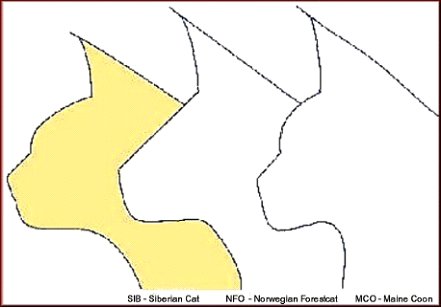
Picture from http://mainecoon-world.ru/viewtopic.php?f=30&t=446
The difference between heads of SIBs, NFCs, and MCOs, is clearly seen in the above diagram. The head of a SIB lacks such extremities as exaggerate whisker pads and muzzle of MCO, and straight profile and overall triangle shape of NFC.
The second easiest way to tell these big hardy cats apart is in the face. The Maine Coons profile is closer in appearance to the Siberians, but is longer, and has a more defined drop from the forehead to muzzle.
The Norwegian, with its triangular head and straight profile that earned it the nick-name Wedgie, provides the most striking difference.
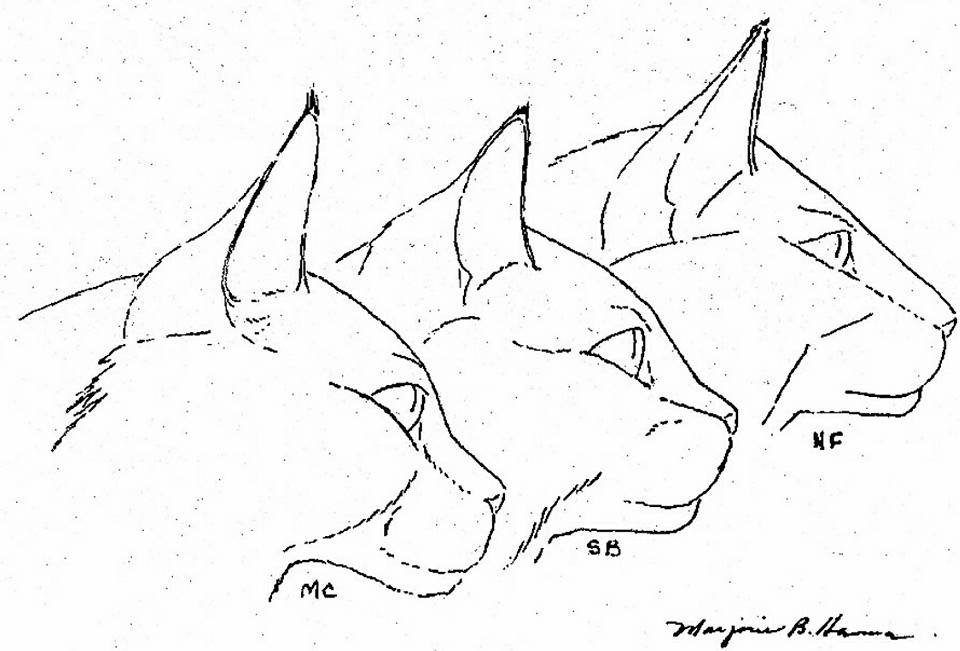
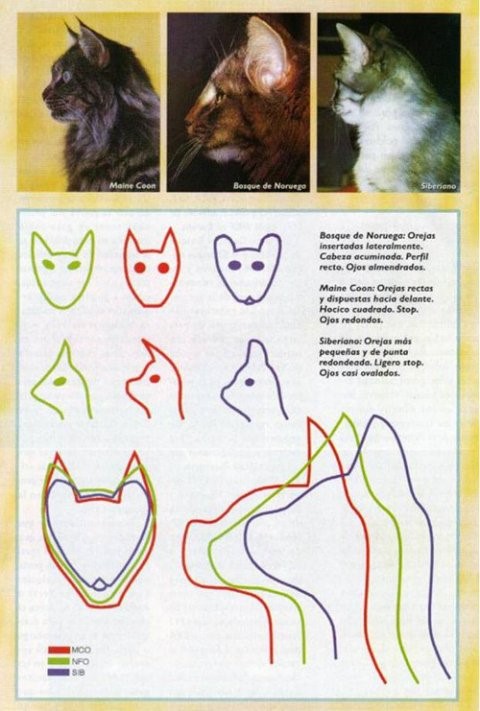
(Pictures from: https://thisbugslife.com/2016/11/11/the-difference-between-siberian-cat-norwegian-forest-cat-and-maine-coon/)
Coat and Ruff
While all of these breeds have lots of fur, the coats do differ a bit.
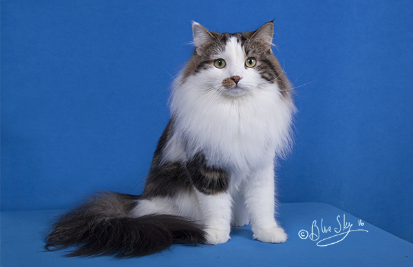
The Norwegian’s double coat has a silky, water-repellant overcoat, and has a frontal ruff round the neck. Moderately long to long on body; shorter on shoulders and on chest. Full ruff on adults. (Picture by Blue Skye: Redzone Gavin of Kerrisma)
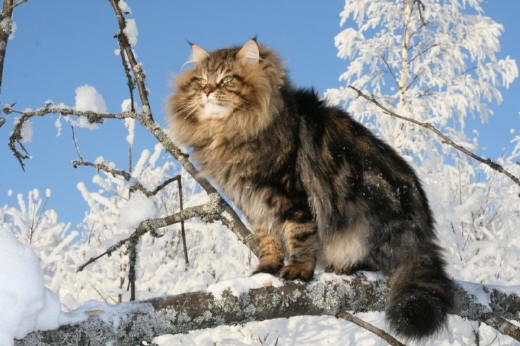
The Siberian has a triple coat, and in the winter the ruff is extremely abundant, giving the look of a lion. The hair length on the body is medium-long, slightly shorter on shoulders and chest. Full ruff on adults. (Picture from: https://www.google.ca/search?q=siberian+cat+on+deck+pictures&tbm=isch&tbo=u&source=univ&sa=X&ved=0ahUKEwir3bGrp4DaAhXFY98KHR9UC0gQ7AkIQA&biw=1421&bih=531#imgrc=l7shQxxxj4kkAM:&spf=1521734660596)
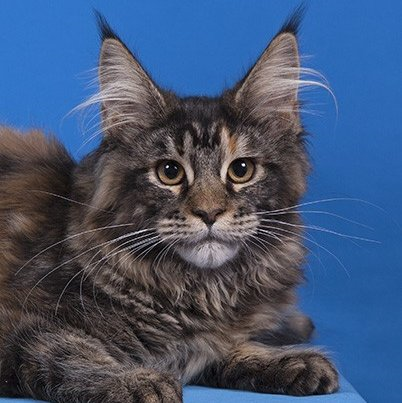
The Maine Coon’s coat is uneven and shorter around the shoulders, and only has a short undercoat. The coat generally is shaggier, with a smaller ruff than the other two breeds. Moderately long to long on body. Full ruff on adults. (Picture from: https://www.cca-afc.com/Breeds/Default)
All colors are accepted in all three breeds with the exception of pointed colors in the Norwegian Forest Cats and the Maine Coons.
Tail
These three breeds are particularly proud of their wide, fluffy tails.
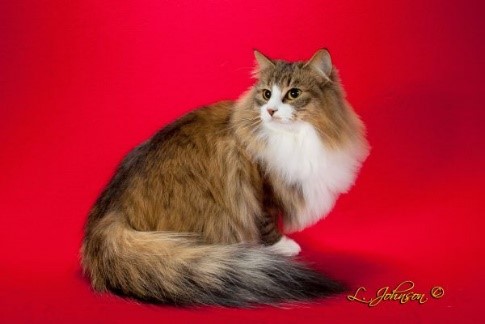
The Norwegian’s tapers to a tip with full and flowing hair. It’s at least as long as the body from shoulders to the base of the tail. (Picture by Larry Johnston: Nordictale Dorothy of Kerrisma)
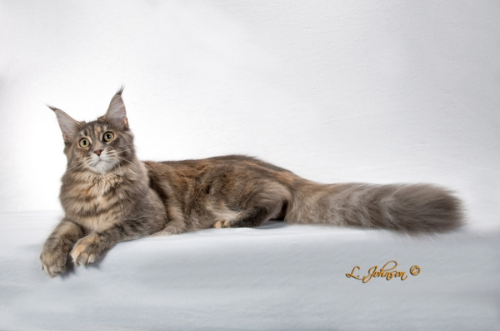
The Maine Coon’s also is as long as the body, but it tapers to a bushy end. (Picture from: https://www.cca-afc.com/Breeds/Default)
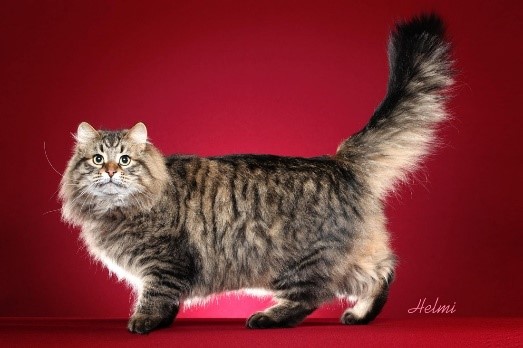
The Siberian’s is blunt at the tip and not as long as the other two breeds, but it makes up for this shorter length by draping gracefully down both sides. (Picture from: https://www.google.ca/search?q=pictures+of+siberian+forest+cats+by+helmi+flick&tbm=isch&tbo=u&source=univ&sa=X&ved=0ahUKEwjY_MbApIDaAhVyleAKHZwSCdcQ7AkIRA&biw=1421&bih=531#imgrc=WF5jTz81cKV1gM:&spf=1521733894860)
Ears
Siberian - Medium long, wide at base with rounded tip. Set 1 to 1 1/2 ear widths apart and tilting forward. Set almost as much on the sides as on the top of the head.
Maine Coon - Large, wide at base and tapered to a point. Set high and well apart.
Norwegian Forest Cat - Medium to large, slightly rounded at tip. Spaced wider and tilted more forward. Set as much on sides as on the top of head.
Eyes
Siberian - Large, almost oval. Wide set with outer corner slightly angled toward the lower base of ear.
Maine Coon - Large, wide set. Slight oblique angle.
Norwegian Forest Cat - Large, almond shaped. Set at slight angle.
Two ways to tell a Siberian from a Maine Coon and a Norwegian are by their ears and their eyes. A Siberians eyes are large, nearly round and set at a medium width apart. Their ears tend to be moderate in size. In contrast, a Maine Coons eyes are also large and round, but tend to be slight slanted and are set wide apart, and a Norwegians eyes are almond-shaped. Maine Coons and Norwegian also tend to have very large ears.
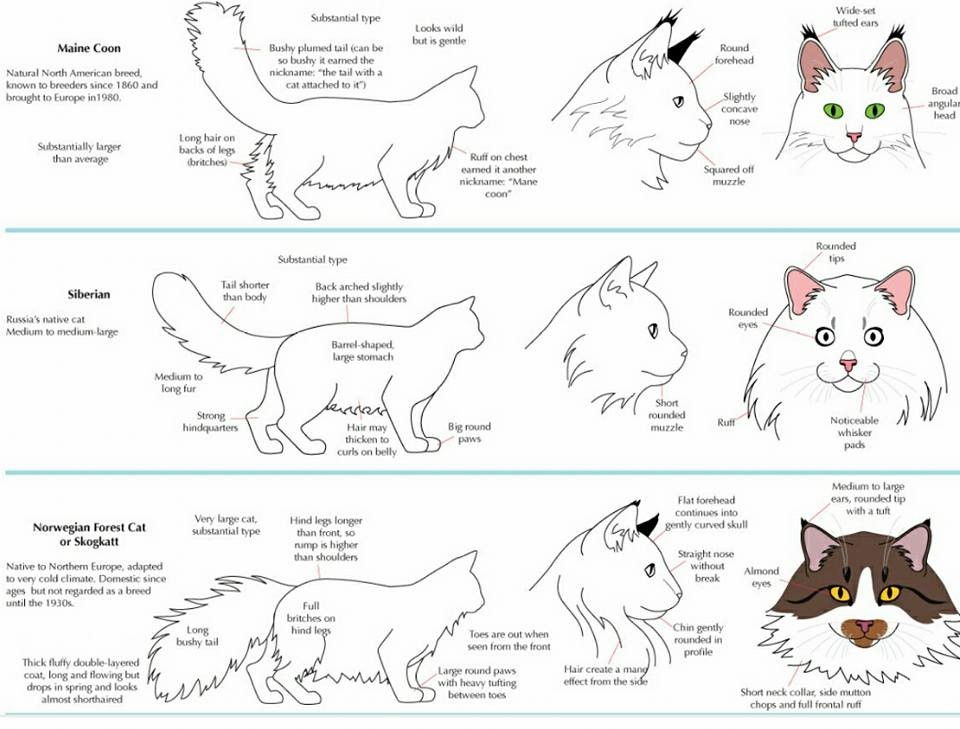 (Picture from: https://thisbugslife.com/2016/11/11/the-difference-between-siberian-cat-norwegian-forest-cat-and-maine-coon/)
(Picture from: https://thisbugslife.com/2016/11/11/the-difference-between-siberian-cat-norwegian-forest-cat-and-maine-coon/)
Body
Siberian - Heavy, moderately long and substantial with rump slightly higher than withers. Back slightly arched. Convex muscular torso and compact belly with age.
Maine Coon - Large, long and muscular; rectangular.
Norwegian Forest Cat - Medium length with rump higher. Siberian cats are easily confused with Maine Coons and Norwegian Forest Cats. However, a closer inspection reveals differences, and probably the most noticeable of these, is the body shape. The Siberian has a rounder, stockier body compared with the Maine Coon or Norwegian.
Legs
Siberian - Moderately long with heavy boning and musculature. Hind legs longer. Large round feet. Toe tufts desirable.
Maine Coon - Medium length. Substantial and wide set. Toe tufts.
Norwegian Forest Cat - Medium length with hind legs longer. Toe tufts. This is the only breed of cat that is allowed in the breed description to toe out.
For a quick Reference chart, please click this link.
(Chart is based on chart from: http://www.vanircats.com/difference.html)